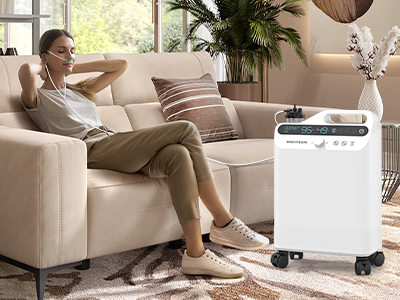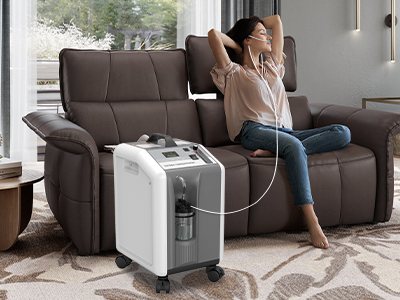11 Jun 2024
Home oxygen therapy is a treatment method that allows patients to receive supplemental oxygen in the comfort of their own homes. This therapy is particularly beneficial for those with chronic respiratory conditions, enabling them to lead more active and fulfilling lives.
Oxygen is a fundamental element for sustaining life. It is critical for cellular respiration, which powers the body’s metabolic processes. For individuals with certain medical conditions, the ability to efficiently absorb oxygen is compromised, necessitating supplemental oxygen to maintain adequate oxygen levels in the blood.

Understanding Oxygen Therapy
A. What is Oxygen Therapy?
Oxygen therapy involves the administration of oxygen at concentrations higher than those found in ambient air. This medical intervention helps alleviate symptoms associated with low blood oxygen levels, such as shortness of breath, fatigue, and confusion.
B. Medical Conditions Requiring Oxygen Therapy
Several medical conditions may necessitate the use of oxygen therapy, including Chronic Obstructive Pulmonary Disease (COPD), pulmonary fibrosis, heart failure, and severe asthma. Oxygen therapy can also be critical for patients recovering from pneumonia or other respiratory infections.
Types of Home Oxygen Therapy
A. Oxygen Concentrators
Oxygen concentrators are devices that extract oxygen from the surrounding air, providing a continuous supply of oxygen. They are efficient for long-term use and are available in both stationary and portable models.
B. Compressed Gas Cylinders
Compressed gas cylinders store oxygen in a high-pressure tank. These cylinders are commonly used for short-term oxygen therapy or as a backup for oxygen concentrators.
C. Liquid Oxygen Systems
Liquid oxygen systems store oxygen in a liquid state, which allows for a larger volume of oxygen to be stored in a smaller space. This system is suitable for patients who require high-flow oxygen.
Setting Up Home Oxygen Therapy
A. Choosing the Right Equipment
Selecting the appropriate oxygen therapy equipment depends on the patient’s medical needs, lifestyle, and mobility. Healthcare providers play a crucial role in recommending the best options.
B. Installation and Safety Precautions
Proper installation of oxygen therapy equipment is essential for safety and efficiency. It is important to follow guidelines for placement, avoid open flames, and ensure that equipment is regularly inspected and maintained.

Using Home Oxygen Therapy
A. Daily Use and Maintenance
Daily use of home oxygen therapy involves setting up the equipment, adjusting the flow rate as prescribed, and wearing the oxygen delivery device. Regular maintenance includes cleaning filters and checking for leaks.
B. Monitoring Oxygen Levels
Patients should monitor their oxygen levels using a pulse oximeter. Keeping track of oxygen saturation levels helps in adjusting therapy and informing healthcare providers about any changes.
Benefits of Home Oxygen Therapy
A. Improved Quality of Life
Home oxygen therapy significantly enhances the quality of life by alleviating symptoms of hypoxemia, allowing patients to perform daily activities with greater ease and comfort.
B. Enhanced Physical Activity
With adequate oxygenation, patients can engage in physical activities that were previously difficult, thereby improving overall health and well-being.
C. Better Sleep and Mental Health
Supplemental oxygen can improve sleep quality and reduce cognitive impairments caused by low oxygen levels, leading to better mental health and emotional stability.
Challenges and Solutions
A. Managing Equipment
Managing oxygen therapy equipment can be challenging. Solutions include training sessions for patients and caregivers, and having a reliable support system in place.
B. Addressing Mobility Issues
Portable oxygen concentrators and lightweight cylinders can help address mobility issues, allowing patients to move freely and maintain an active lifestyle.
C. Overcoming Social and Psychological Barriers
Social and psychological barriers, such as stigma and anxiety, can be mitigated through education, support groups, and counseling services.
Frequently Asked Questions
A. How to Travel with Oxygen Therapy?
Traveling with oxygen therapy requires planning and coordination. Patients should inform airlines, arrange for portable equipment, and have a prescription on hand.
B. Can You Exercise with Oxygen Therapy?
Exercise is encouraged with oxygen therapy. Patients should consult their healthcare provider to develop a safe and effective exercise plan.
C. What are the Costs Involved?
The costs of oxygen therapy can vary. Insurance may cover some expenses, and financial assistance programs are available for those who qualify.
Conclusion
Patients and caregivers are encouraged to seek guidance from healthcare providers, stay informed about their condition, and utilize available resources to manage oxygen therapy effectively. With proper support and management, home oxygen therapy can lead to a more active and fulfilling life.
Keywords: oxygen therapy
Originally published 11 Jun 2024, updated 11 Jun 2024.